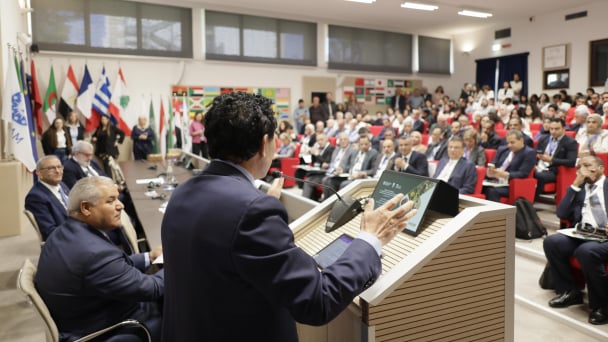May 14, 2025 | 16:59 GMT +7
May 14, 2025 | 16:59 GMT +7
Hotline: 0913.378.918
May 14, 2025 | 16:59 GMT +7
Hotline: 0913.378.918

The Institute of Agricultural Science and Technology in the South Central Coast has created two new varieties of mung beans, DXBD.07 and DXBD.08. Photo: V.D.T.
For a long time, the green bean variety that farmers in Binh Dinh province have widely planted is the DX208 variety, with many advantages such as good yield and quality. However, because this mung bean variety DX208 is now degenerated, often infected with pests and diseases, especially leaf mosaic disease. In addition, this mung bean variety does not ripen centrally, prolonging the season, so it is challenging to put mechanization into the harvesting stage.
Faced with the above fact, the Institute of Agricultural Science and Technology in the South Central Coast has created two new varieties of mung beans, DXBD.07 and DXBD.08, to diversify mung bean varieties in the area. These new mung bean varieties are resistant to leaf mosaic disease and mature in concentration, enabling farmers to mechanize harvesting and reduce labor.
In the 2022 spring crop, The Institute of Agricultural Science and Technology in the South Central Coast built a demonstration production model of two new green bean varieties, DXBD.07 and DXBD.08, with an area of 1 hectare in Thiet Tru village, Nhon Hau commune. (An Nhon town, Binh Dinh), the control variety is DX208.
According to Mr. Nguyen Thanh Trung, Head of Agriculture Extension Department (under Binh Dinh Agricultural Extension Center), over the past time, Binh Dinh Agricultural Extension Center has continuously deployed many models of testing new mung bean varieties to serve the transformation of the plant structure in the province. The introduction of two new mung bean varieties, DXBD.07 and DXBD.08, selected by The Institute of Agricultural Science and Technology in the South Central Coast, has given Binh Dinh farmers more choices in production.

Leaf mosaic disease on mung beans is the obsession of farmers. Photo: V.D.T.
After visiting the model, Mr. Nguyen Thanh Trung commented: "The two new varieties of mung beans with ripe fruit are more concentrated than the ones that farmers are mass producing, namely DX108. This advantage of the two new mung bean varieties has shortened the time for farmers in the field, suitable for cultivating two crops per year.
Farmer Nguyen Ngoc Anh in Thiet Tru village has produced two new mung bean varieties, DDBD.07 and DDBD.08, over two seasons. In the spring crop of 2022, Mr. Anh continued to plant 1,500m2 of two new varieties of green beans and obtained 14 kilograms of fruit, resulting in a yield of 280-290 kilograms per hectare.
"When I was still growing mung bean variety DX208, I had to harvest three times each crop to finish, while two new mung bean varieties were only harvested twice thanks to ripening at a time point, saving labor cost. The two new mung bean varieties are also less susceptible to root rot than the DX208 variety. In particular, the two new varieties are resistant to leaf mosaic disease. Farmers get rid of big worries, and the yield is higher than the DX208 variety, so the profit is higher", Mr. Anh shared.
According to farmers' calculations, two new mung bean varieties, DXBD.07 and DXBD.08, are produced according to the process of The Institute of Agricultural Science and Technology in the South Central Coast, reducing costs compared to DX208 by more than VND 2.1 million/hectare/crop, net profit is nearly VND 23.3 million/hectare, VND 6.6 million/hectare higher than DX208 variety.
According to Mr. Pham Vu Bao, Deputy Director of The Institute of Agricultural Science and Technology in the South Central Coast, leaf mosaic disease on mung beans often causes severe damage to yield; the damage can range from 10-100% depending on infected tree segments, leading to the risk of crop failure.

Farmers visit the model of 2 new mung bean varieties, DXBD.07 and DXBD.08, in Thiet Tru village, Nhon Hau commune (An Nhon town, Binh Dinh). Photo: V.D.T.
In Vietnam, leaf mosaic disease causes severe damage to mung beans in the Central and Central Highlands regions in the summer-autumn crop's hot and sunny conditions. In addition, farmers in Binh Dinh mass-grown the degenerated mung bean variety, DX208, which does not ripen in concentration, prolonging the harvest time and creating more favorable conditions for harmful diseases.
According to Mr. Bao, before the situation of mung bean plants in the South Central Coast and Central Highlands infected with leaf mosaic disease, The Institute of Agricultural Science and Technology in the South Central Coast has developed a strategy to select and create mung bean varieties having a short growth period, full ripening, high yield, and especially resistance to leaf mosaic disease.
The source of materials to select and create two new mung bean varieties, DXBD.07 and DXBD.08, were obtained by The Institute of Agricultural Science and Technology in the South Central Coast from the Asian International Vegetable Research Center, which are two hybrid combinations of single NM94 and KPS2, two cultivars with genes for resistance to viral leaf mosaic disease on mung beans.
After hybridization, the Institute selected and used molecular techniques to test the resistance gene for leaf mosaic disease in selected lines and varieties. After checking that there are virus resistance genes in newly elected lines and varieties of mung beans, the Institute has conducted an assessment through production practices, especially in areas under severe pressure of leaf mosaic disease.
"The production practice clearly shows that the resistance to leaf mosaic disease of two new mung bean varieties DXBD.07 and DXBD.08 is many times higher than that of the old degenerated variety DX208. Depending on the pressure of the production area, especially in Gia Lai province, where the green bean area is thousands of hectares, there are mung bean areas infected with leaf mosaic disease up to 60-80%. The two new varieties of mung beans DXBD.07 and DXBD.08 suffer leaf mosaic disease is less than 5%", said Mr. Pham Vu Bao.
"In Binh Dinh province, under the weather conditions of the 2022 spring crop, the varieties DXBD.07, DXBD.08 showed no signs of leaf mosaic disease. The varieties DXBD.07 and DXBD.08 were only mildly infected with leaf rollers and fruit borers with less than 10%, while DX208 varieties were more severely infected.
Under natural disease pressure due to not spraying pesticides, monitoring leaf mosaic disease on mung beans in 35 days and 55 days after sowing in Gia Lai and Dak Lak provinces. We found the mung bean varieties DXBD.07 and DXBD.08 selected from a cross with the mother variety NM94, are highly resistant to leaf mosaic disease", said Mr. Pham Vu Bao, Deputy Director of The Institute of Agricultural Science and Technology in the South Central Coast.
Translated by Ha Phuc

(VAN) Data from 10,000 farming households will help professionalize production organization and support the implementation of the One Million Hectares Program for High-Quality, Low-Emission Rice Cultivation.

(VAN) FAO Director-General QU Dongyu marks International Day of Plant Health at NENA conference.

(VAN) Deputy Minister of Agriculture and Environment Hoang Trung affirmed that floriculture and ornamental plants are a growing industry that receives significant global attention.

(VAN) The three staple crops dominating modern diets – corn, rice and wheat – are familiar to Americans. However, fourth place is held by a dark horse: cassava.
/2025/05/10/4037-3-223011_495.jpg)
(VAN) Remote sensing technology is becoming an indispensable tool in monitoring resources, developing modern agriculture, and protecting the environment in Vietnam.

(VAN) The trash bag used on fishing vessels can withstand rough sea conditions, including level 8 to level 10 winds and waves. Notably, it can be hung anywhere on the boat.

(VAN) African leaders launched the Kampala Declaration on Building Resilient and Sustainable Agrifood Systems in Africa, marking a bold step toward transforming the continent's agriculture.